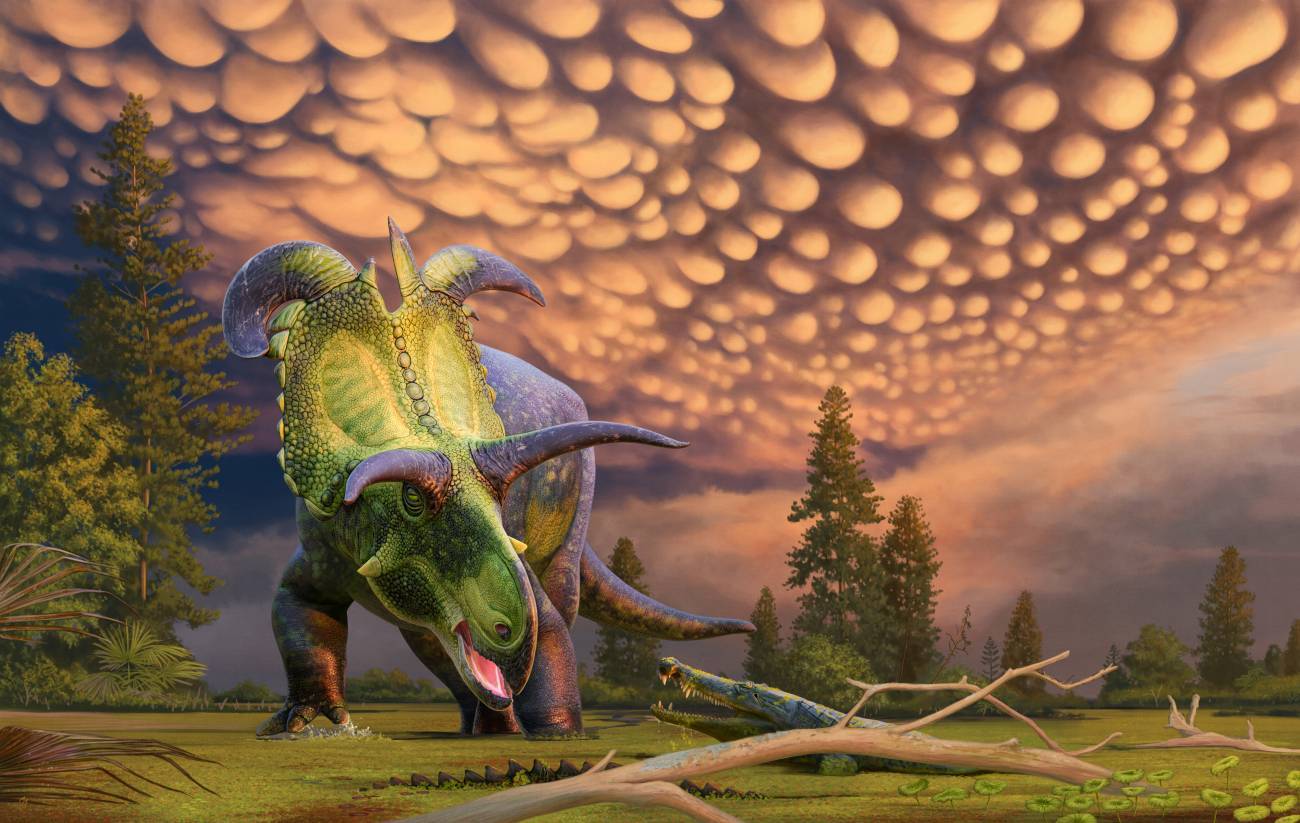Located a few miles from the US-Canada border Judith River Formation, Northern Montana. At this location are the fossil remains of a dinosaur – a skull and partial skeleton – which has just been identified as a new species: Lokiceratops rangiformis.
This animal had two huge horns in the shape of blades on its back and that is why it got its name, which means: “Loki’s horned face resembling a caribou.” It is about fourth centrosaurus and fifth horned dinosaur overall, identified at this location.
The discovery, published by the magazine Peerj, This was made possible thanks to the work of a group of scientists led by the Utah Museum of Natural History (USA). The remarkable thing about this specimen is that it is one of the horned herbivorous dinosaurs largest and most ornate ever found.
“Each of the animals in Montana’s Judith River Formation ecosystem had a different pattern of ornaments on their noses, above their eyes and along the back of their head shields. “We believe these decorations are used to attract mates and intimidate rivals of the same species,” he says. Mark Loewenpaleontologist at the museum and lead co-author of the study.
The giant, who measured approximately 6.7 meters long and weighed about 5 tonsis a member of the ceratopsids, a group that emerged about 92 million years ago during the Upper Cretaceousand that diversified and persisted until the end of the dinosaur age.
“The ornaments on the skulls of ceratopsians are currently the main way we can distinguish the species. Like decorated birds and mammals such as antelope, these ornaments were probably used for display,” he says Joseph Sertich, co-director of the study and paleontologist at the Smithsonian Tropical Research Institute and Colorado State University (USA).
Just like others dinosaurs herbivorous ceratopsians, Lokiceratops It had a mouth full of more than 200 sharp teeth and cut through vegetation, including small branches.

Inhabited the swamps and floodplains along the east coast of Laramidia
Lokiceratops rangiformis appeared at least 12 million years before it became famous primo Triceratops and it was the largest horned dinosaur of its time, as confirmed by this study.
More than 78 million years ago, Lokiceratops rangiformis It inhabited the swamps and floodplains along the east coast of Laramidia. This island continent represents what is now the western part of North America, created when a great seaway divided the continent about 100 million years ago. Since then, mountain building and dramatic changes in climate and sea levels have transformed the greenhouse world of Laramidia where they thrived. Lokiceratops rangiformis and other dinosaurs.
Remains of more dinosaurs found in the same layers as Lokiceratops rangiformis include ceratopsid dinosaurs Judiceratops, Albertaceratops, Medusaceratops j Wendiceratopsand the duck-billed dinosaur Probrachylophosaurus. They were probably hunted by a tyrannosaurus that resembled Tyrannosaurus Thanatotheristes.
“We still don’t know exactly which tyrannosaurus lived with these species, more fossils need to be found. At that time, the global greenhouse expanded tropical and subtropical ecosystems much further north than they do today,” Sertich points out.
According to Loewen: “Lokiceratops lived in a subtropical coastal area covered with forests, small lakes and swamps along the east coast of Laramidia, the island mass of western North America,” Loewen continues.
The high endemism observed in centosaurs implies that dinosaur diversity is currently underestimated
Analysis of the remains suggests that this family of horned dinosaurs underwent rapid evolution and lived in relatively small geographic areas across the continental mass of the continent. Laramidia Island.
He high endemism observed in centosaurs implies that dinosaur diversity is currently underestimated and not directly comparable to the large (historical) geographic ranges observed in most large mammals today.
“We didn’t expect to go to the Serengeti and find five species of elephants living together, and these animals are the same size. The only way to maintain this level of hyperdiversity is because they are separated by mating preferences and courtship behavior, similar to that of some modern birds and fish,” Loewen explains.
To Sertich, this very high richness shows rapid diversification or speciation, indicating that these Laramidia ecosystems could support highly diverse dinosaur faunas. “This evolution is probably related to climate changes in a dynamic landscape. It also suggests that there are many dinosaurs waiting to be discovered,” he points out.
Paleontologists used to think that there were at most two species dinosaurs with horns in the same place and at the same time, but horned dinosaurs were more diverse than previously thought.
Scientists have discussed the patterns of evolution within the group dinosaurs cuckolds over the years. “We now recognize more than 30 species of centrosaurus within the larger group of horned dinosaurs, with more being described every year,” he notes. Andreas Wakker, from the Raymond M. Alf Museum of Paleontology. (UNITED STATES).
Many dinosaur groups had large geographic ranges. Centrosaurines do not appear to have them, resulting in a higher level of diversity. “At the same time, if each region specifies due to sexual selection, it could support more species that eat and live functionally in the same way, similar to cichlid fish in some Rift Valley lakes,” says the Utah Museum of Natural History researcher.
Other unrelated dinosaurs have been found elsewhere at sites of similar age. This suggests that they were endemic to only part of Laramidia.
Reference:
“Lokiceratops rangiformis gen. and sp. Nov. (Ceratopsidae: Centrosaurinae) from the Campanian Judith River Formation in Montana reveals rapid regional radiation and extreme endemism in centrosaurine dinosaurs.” PeerJ.

